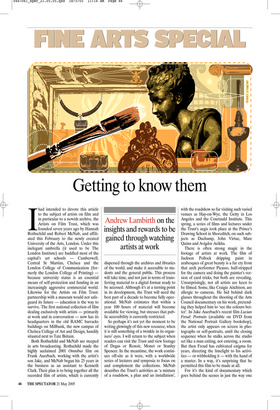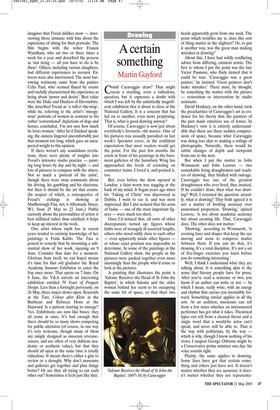Getting to know them
Andrew Lambirth on the insights and rewards to be gained through watching artists at work
Ihad intended to devote this article to the subject of artists on film and in particular to a newish archive, the Artists on Film Trust, which was founded seven years ago by Hannah Rothschild and Robert McNab, and affiliated this February to the newly created University of the Arts, London. Under this inelegant umbrella (it used to be The London Institute) are huddled most of the capital’s art schools — Camberwell, Central St Martins, Chelsea and the London College of Communication (formerly the London College of Printing) because university status is an essential means of self-protection and funding in an increasingly aggressive commercial world. Likewise for the Artists on Film Trust: partnership with a museum would not safeguard its future — education is the way to survive. The first national collection of film dealing exclusively with artists — primarily at work and in conversation — now has its headquarters in the old RAMC barracks buildings on Millbank, the new campus of Chelsea College of Art and Design, handily situated next to Tate Britain.
Both Rothschild and McNab are steeped in arts broadcasting. Rothschild made the highly acclaimed 2001 Omnibus film on Frank Auerbach, working with the artist’s son Jake, and McNab began his 25 years in the business as an assistant to Kenneth Clark. Their plan is to bring together all the recorded film of artists, which is currently dispersed through the archives and libraries of the world, and make it accessible to students and the general public. This process will take time, and not just in terms of transferring material to a digital format ready to be accessed. Although it’s at a turning point in its development, the Trust will need the best part of a decade to become fully operational. McNab estimates that within a year 100 hours of material will become available for viewing, but stresses that public accessibility is currently restricted.
So perhaps it’s not yet the moment to be writing glowingly of this new resource, when it is still something of a twinkle in its organisers’ eyes. I will return to the subject when readers can visit the Trust and view footage of Degas or Renoir, Monet or Stanley Spencer. In the meantime, the work continues off-site as it were, with a worldwide series of lectures and symposia to focus on and complement the collections. McNab describes the Trust’s activities as ‘a mixture of a roadshow, a plan and an installation’, with the roadshow so far visiting such varied venues as Hay-on-Wye, the Getty in Los Angeles and the Courtauld Institute. This spring, a series of films and lectures under the Trust’s aegis took place at the Prince’s Drawing School in Shoreditch, on such subjects as Duchamp, John Virtue, Marc Quinn and Avigdor Arikha.
There is often strong magic in the footage of artists at work. The film of Jackson Pollock dripping paint in arabesques of great beauty is a far cry from that arch performer Picasso, half-stripped for the camera and doing the painter’s version of card tricks, but both are revealing. Unsurprisingly, not all artists are keen to be filmed. Some, like Craigie Aitchison, are allergic to cameras. He hid behind dark glasses throughout the shooting of the Arts Council documentary on his work, pretending they helped him to ‘see the colours better’. In Jake Auerbach’s recent film Lucian Freud: Portraits (available on DVD from the National Portrait Gallery bookshop), the artist only appears on screen in photographs or self-portraits, until the closing sequence when he stalks across the studio set like a man exiting, not entering, a room. But then Freud has cultivated enigma for years, directing the limelight to his activities — or withholding it — with the hand of a master. In a way, it’s surprising that he permitted this film to be made at all.
For it’s the kind of documentary which goes behind the scenes in just the way one imagines that Freud dislikes most — interviewing those intimate with him about the experience of sitting for their portraits. The film begins with the writer Francis Wyndham, who sat two or three times a week for a year and described the process as ‘not tiring — all you have to do is be there’. Others, including various daughters, had different experiences to recount. Exlovers were also interviewed. The most harrowing testimony came from the painter Celia Paul, who seemed flayed by events and ruefully characterised the experience as being about ‘power and desire’. Best value were the Duke and Duchess of Devonshire. She described Freud as ‘a will-o’-the-wisp’, while he, referring to the artist’s ‘misogynous’ portraits of women in contrast to his rather ‘conventional’ depictions of dogs and horses, concluded, ‘I’m not sure how much he loves women.’ After he’d finished speaking, the camera lingered uncomfortably just that moment too long, which gave an unexpected weight to this opinion.
If there weren’t any scandalous revelations, there were plenty of insights into Freud’s intensive studio practice — painting long hours by day and by night — and lots of pictures to compare with the sitters. Not so much a ‘portrait of the artist’, though there were stray comments about his driving, his gambling and his charisma, but then it should be the art that counts. (In respect of which, a retrospective of Freud’s etchings is showing at Marlborough Fine Art, 6 Albemarle Street, W1, from 25 May to 23 June.) Public curiosity about the personalities of artists is best titillated rather than satisfied; it helps to keep up interest in the work.
One artist whose myth has in recent years tended to outstrip knowledge of her paintings is Frida Kahlo. The Tate is poised to remedy that by mounting a substantial show of her work, opening on 9 June. Consider that date for a moment. Glorious June (well, we can hope) means it’s time for that old gladiator the Royal Academy Summer Exhibition to enter the fray once more. That opens on 7 June. On 8 June, the V&A unveils an interesting exhibition entitled 70 Years of Penguin Design. Less than a fortnight previously, on 26 May, three major shows open: Reynolds at the Tate, Colour after Klein at the Barbican and Rebecca Horn at the Hayward. Is a pattern starting to emerge? Yes. Exhibitions are now like buses: they all come at once. It’s bad enough that there should be so many shows competing for public attention (of course, in one way it’s very welcome, though many of them are simply designed as museum revenueraisers, and are often of very dubious academic or aesthetic value), but that they should all open at the same time is totally ridiculous. It means there’s either a glut to review or a drought. Why don’t museums and galleries get together and plan things better? Or are they all trying to cut each other out? Sometimes it feels just like that.


























































 Previous page
Previous page